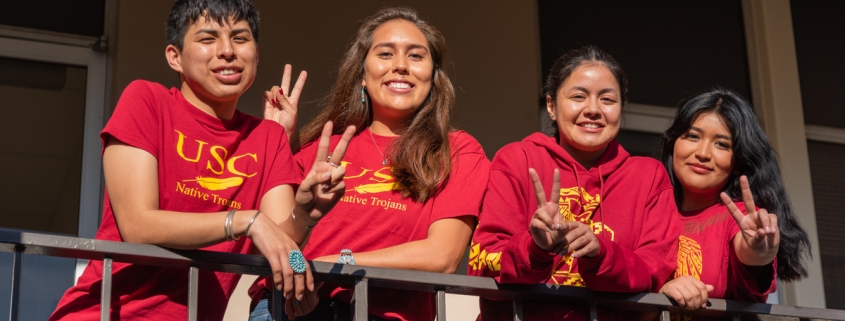Students to expand Native American group

Kolton Nephew, a sophomore majoring in political science, grew up on the Navajo Nation reservation in Arizona’s Four Corners region. After transferring from Fort Worth College, a school with a 27% Native American student body, Nephew said he experienced culture shock.
USC is composed of a student body that is 1% Native American, according to a diversity breakdown published by the University in 2016 — a stark difference from Nephew’s first school.
“I didn’t know how to react with so many different cultures around me or not seeing familiar faces or familiar languages spoken,” Nephew said. “I felt like I needed to at least connect with people who had a similar background as me, if not the same nation as me.”
As an active member of USC’s Native American Student Union since Fall 2019, Nephew found community in the organization and with its 30 active members, who identify with the club’s goal of establishing a cultural center for Native American students and others interested in Native American issues and culture.
However, NASU has repeatedly been denied recognition as an Undergraduate Student Government cultural assembly because of a bylaw that requires that a group be affiliated with five recognized student organizations to become an assembly. But this may change following a proposed amendment to the bylaw, allowing organizations to submit a petition of at least 50 signatures to become an assembly under USG.
“[We’re] trying to revise this process so that it’s more feasible for smaller communities on campus to become cultural assemblies,” USG Chief Diversity Officer Jeffrey Cho said. “[We’re] thinking about creating this petition system where, potentially, if enough students sign this petition, then [NASU is] allowed to start the process of becoming a cultural assembly.”
The organization is currently categorized as a religious group.

“[NASU members are] passionate and determined, and in an institution that still doesn’t really choose to recognize us, we’re limited to a religious center,” Nephew said. “That’s demoralizing to us as Native Americans — saying that what we are is more of a religion than who we are as a lifestyle.”
Chase said she also noticed how limited Native American student resources are at USC compared to her high school, which was located near her Navajo reservation.
“Back at my high school, we had so much support for different Native American groups,” Chase said. “We would host powwows, ceremonies, all the time. It was such a weird transition coming here to USC when none of that is present. It’s opened my eyes, and it’s made me want to bring that kind of community here.”
For some, the challenges of their Native American identities began before college. Vice President Moakeah Rivera said that growing up in the affluent community of Encinitas, she was patronized and treated differently from her peers.
“I was raised in a very privileged area where I was a token,” Rivera said. “I was only treated nicely because I was the only [Native American].”
Rivera said tensions between Native American groups and other communities develop when non-Native Americans perceive that Native Americans are receiving special treatment, such as affirmative action. However, she said these policies are necessary to close the gaps in educational opportunities.
“Native Americans are the least funded in their education systems — we’re separated from the rest of the world,” Rivera said. “There’s a lot of things that affect us in our college, in our childhoods that other people can’t understand.”
Chase added that Native Americans receive comparatively little recognition in postsecondary education.
“I think it’s just the struggle that Native American students face in general when it comes to pursuing a second education,” Chase said. “[You’re] always trying to find a little crack, a sliver through to be able to catch up with everyone else.”
While acquiring resources and members are high on the group’s agenda, its main goal is to transition as a member of the Interfaith Council — an umbrella organization of religious groups on campus — to a cultural assembly under USG, like the Black and Latinx student assemblies.
“We would have a greater voice in how we are represented [if we became an assembly],” Rivera said. “We would also get funding, which would actually help us greatly with advocating and our outreach work … We just want to be treated like every other ethnic group within USG.”
Chase said she was frustrated with the common argument that NASU’s membership is too small to establish it as a cultural assembly.
“We have been told that we don’t have the numbers to be able to make that transition and make our presence known, which is unfortunate because … it’s not something that we have control over,” Chase said. “Being able to have [the University’s] support would mean so much.”
At its core, NASU membership is a way for students with common experiences to share their culture and build a community, Chase said.
“When you look at Native American cultures, we’re so family oriented,” Chase said. “It’s just so hard to be away from that, so when we come here as a group of people, we’re able to create our own little family. We’re able to keep our culture, which is amazing.”

